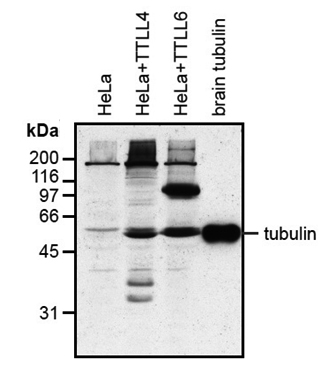anti-Polyglutamylation Modification mAb (GT335)
Product Code:
AG-20B-0020
AG-20B-0020
Host Type:
Mouse
Mouse
Antibody Isotype:
IgG1κ
IgG1κ
Antibody Clonality:
Monoclonal
Monoclonal
Antibody Clone:
GT335
GT335
Regulatory Status:
RUO
RUO
Target Species:
Universal
Universal
Applications:
- Immunocytochemistry (ICC)
- Immunoprecipitation (IP)
- Western Blot (WB)
Shipping:
Blue Ice
Blue Ice
Storage:
-20°C
-20°C
No additional charges, what you see is what you pay! *
| Code | Size | Price |
|---|
| AG-20B-0020-C100 | 100 ug | £371.00 |
Quantity:
Prices exclude any Taxes / VAT
Stay in control of your spending. These prices have no additional charges to UK mainland customers, not even shipping!
* Rare exceptions are clearly labelled (only 0.14% of items!).
* Rare exceptions are clearly labelled (only 0.14% of items!).
Multibuy discounts available! Contact us to find what you can save.
This product comes from: Switzerland.
Typical lead time: 7-10 working days.
Contact us for more accurate information.
Typical lead time: 7-10 working days.
Contact us for more accurate information.
- Further Information
- Documents
- References
- Show All
Further Information
Alternate Names/Synonyms:
Polyglutamylated Tubulin; Glutamylated Tubulin; Postranslational Protein Glutamylation
Concentration:
1mg/ml
EClass:
32160000
Form (Short):
liquid
Formulation:
Liquid. In PBS containing 0.02% sodium azide.
Handling Advice:
After opening, prepare aliquots and store at -20°C.Avoid freeze/thaw cycles.
Immunogen:
Octapeptide EGEGE*EEG, modified by the addition of two glutamyl units onto the fifth E (indicated by an asterisk).
Long Description:
Monoclonal Antibody. Recognizes the posttranslational modification (poly)glutamylation on proteins. Reacts with polyglutamylated alpha- and beta-tubulin. Isotype: Mouse IgG1kappa. Clone: GT335. Applications: EM, ICC, IHC, IP, WB. Liquid. In PBS containing 10% glycerol and 0.02% sodium azide. Polyglutamylation is a post-translational modification in which glutamate side chains of variable lengths are formed on the modified protein. It is evolutionarily conserved and the most prominent substrate is tubulin, the microtubule (MT) building block. Polyglutamylation has been proposed to be involved in the functional adaptation of MTs, as it occurs within the carboxy-terminal tubulin tails that participate directly in the binding of many structural and motor MT-associated proteins. The recent identification of new substrates of polyglutamylation indicates that this post-translational modification could be a potential regulator of diverse cellular processes and be involved in cell cycle and cell proliferation.
NCBI, Uniprot Number:
N/A
Other data:
Recognizes most forms of polyglutamylated tubulin (alpha- and beta-tubulin), independent of the length of the glutamate side chains. No specificity to particular tubulin isoforms nor to tubulin from particular species are observed. Detects also other (poly)glutamylated proteins. Since no consensus modification site is known for protein (poly)glutamylation, the detection is not sequence-specific. However, an acidic environment of the modification site is required. The use of the antibody at too high concentrations obscures its specificity in immunofluorescence.
Package Type:
Plastic Vial
Product Description:
Polyglutamylation is a post-translational modification in which glutamate side chains of variable lengths are formed on the modified protein. It is evolutionarily conserved and the most prominent substrate is tubulin, the microtubule (MT) building block. Polyglutamylation has been proposed to be involved in the functional adaptation of MTs, as it occurs within the carboxy-terminal tubulin tails that participate directly in the binding of many structural and motor MT-associated proteins. The recent identification of new substrates of polyglutamylation indicates that this post-translational modification could be a potential regulator of diverse cellular processes and be involved in cell cycle and cell proliferation.
Purity:
>95% (SDS-PAGE)
Source / Host:
Purified from concentrated hybridoma tissue culture supernatant.
Specificity:
Recognizes the posttranslational modification (poly)glutamylation on proteins. Reacts with polyglutamylated alpha- and beta-tubulin.
Transportation:
Non-hazardous
UNSPSC Category:
Primary Antibodies
UNSPSC Number:
12352203
Use & Stability:
Stable for at least 1 year after receipt when stored at -20°C.
Documents
References
Distribution of glutamylated alpha and beta-tubulin in mouse tissues using a specific monoclonal antibody, GT335: A. Wolff, et al.; Eur. J. Cell Biol. 59, 425 (1992) | Polyglutamylation of nucleosome assembly proteins: C. Regnard, et al.; J. Biol. Chem. 275, 15969 (2000) | Glutamylated tubulin: diversity of expression and distribution of isoforms: M.L. Kann, et al.; Cell Motil. Cytoskeleton 55, 14 (2003) | Polyglutamylation Is a Post-translational Modification with a Broad Range of Substrates: J. van Dijk, et al.; J. Biol. Chem. 283, 3915 (2008) | Unique post-translational modifications in specialized microtubule architecture: K. Ikegami & M. Setou; Cell Struct. Funct. 35, 15 (2010) (Review) | Tubulin detyrosination promotes monolayer formation and apical trafficking in epithelial cells: S. Zink|et al.; J. Cell Sci. 125, 5998 (2012) | The CP110-interacting proteins Talpid3 and Cep290 play overlapping and distinct roles in cilia assembly: T. Kobayashi, et al.; J. Cell Biol. 204, 215 (2014) | CNS axons globally increase axonal transport after peripheral conditioning: F.M. Mar, et al.; J. Neurosci. 34, 5965 (2014) | Microtubule detyrosination guides chromosomes during mitosis: M. Barisic, et al.; Science 348, 6236 (2015) (Supplement) | SAS-6 engineering reveals interdependence between cartwheel and microtubules in determining centriole architecture: M. Hilbert, et al.; Nat. Cell Biol. 18, 393 (2016) | Loss of RPGR glutamylation underlies the pathogenic mechanism of retinal dystrophy caused by TTLL5 mutations: X. Sun, et al.; PNAS 113, E2925 (2016) | Alterations in the balance of tubulin glycylation and glutamylation inphotoreceptors leads to retinal degeneration: M. Bosch Grau, et al.; J. Cell. Sci. 130, 938 (2017) | The actin-MRTF-SRF transcriptional circuit controls tubulin acetylation via alpha-TAT1 gene expression: J. Fernandez-Barrera, et al.; J. Cell Biol. 217, 929 (2018) | iPSCs from a Hibernator Provide a Platform for Studying Cold Adaptation and Its Potential Medical Applications: J. Ou, et al.; Cell 173, 1 (2018) | Klf4 glutamylation is required for cell reprogramming and early embryonic development in mice: B. Ye, et al.; Nat. Commun. 9, 1261 (2018) | Centrosome amplification arises before neoplasia and increases upon p53 loss in tumorigenesis: C.A.M. Lopes, et al.; J. Cell. Biol. 217, 2353 (2018)



